Could Parks Victoria mistake natural white rock & bird poo for climbing chalk in their rush to ban climbing? Yes they could. What you are about to read is one of those big moments where the ineptitude of the PV’s assessment process of rock climbing areas is exposed for what it is. A flawed and amateur attempt to quite literally white-wash climbers in the worst possible light whilst shirking any responsibility. Think the “bolt in art” fiasco was bad? This is better.
In our article last week we revealed a new requirement for Licensed Tour Operators (commercial climbing guides) to obtain their own Cultural Heritage Permit (aka Permit to Harm) if they wanted to continue operating in Summerday Valley in the new financial year. This permit is to enable the guides to “Carry out an activity that will, or is likely to, harm Aboriginal cultural heritage“.
What’s the problem?
“Traditional Owners have raised concerns with Parks Victoria on the impacts that recreational activities, including climbing, have and continue to have on tangible and intangible Aboriginal cultural heritage in the Summerday Valley area.”
What is at stake?
Five quarries and a stone artifact scatter in Summerday Valley.
Who suggested this permit?
“In early 2020 Traditional Owners requested that as part of LTO licence renewal process (National Parks Regulations 2013) that LTOs be advised they must seek their own Cultural Heritage Permit to operate in Summerday Valley.”
The secret documents
As part of this process Parks Victoria has sent the LTOs several documents that described the reasons that this Cultural Heritage Permit is now required. We can’t publish the full documents here for legal reasons but hopefully they will be revealed in full soon. Stay with us here.
This permit is for the most onerous category of harm and costs $681. Significantly more risky/costly than a permit for removing, digging up or selling artifacts. This $681 permit is clearly intended for activities like building, excavation, and destructive work – not climbing.
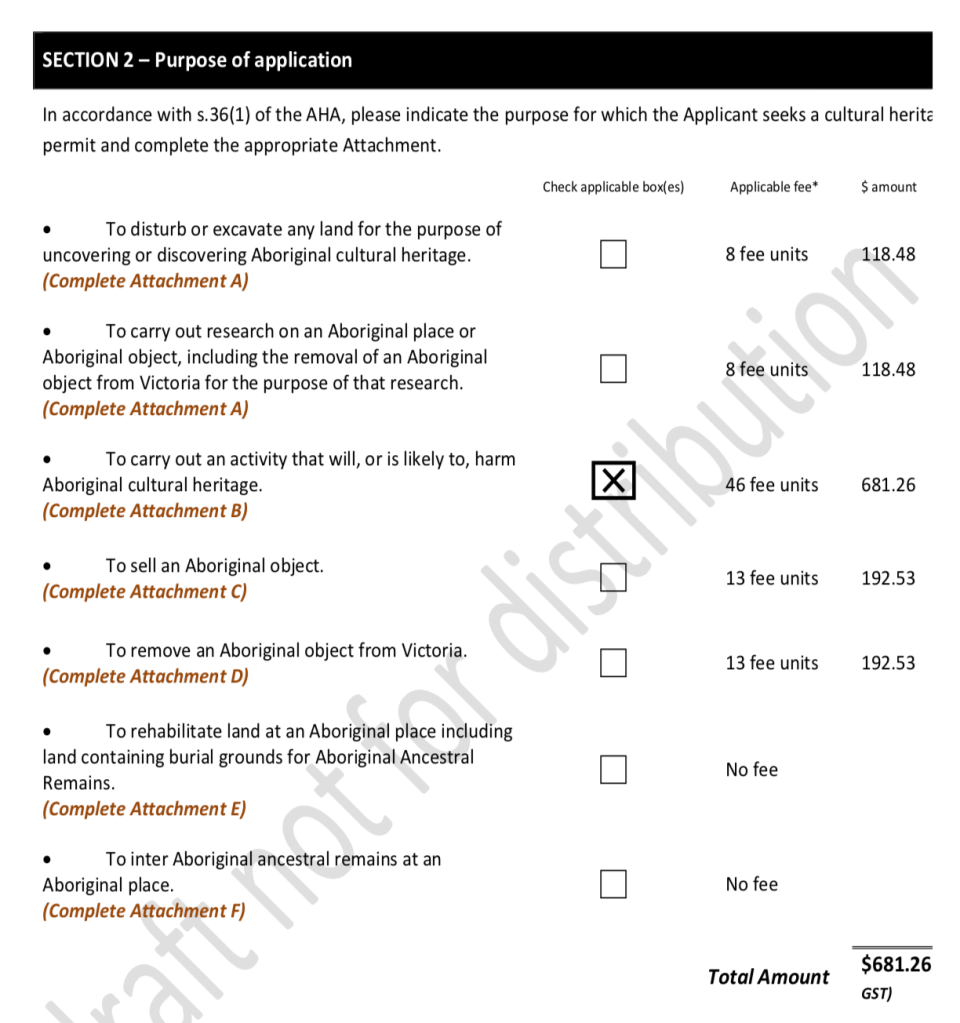
Contradictions
So is this permit allowing harm to cultural heritage or not? None of the climbing guiding companies want any part in harming cultural heritage.
On one hand the permit states “Parks Victoria has negotiated with Traditional Owners and LTOs to ensure that Aboriginal cultural heritage that will or is likely to be harmed by the activities have the relevant authorizations under the Aboriginal Hertiage Act“. But then the same document a few sentences later says it is about “ensuring protection of tangible and intangible cultural heritage values“.
What harm is the permit allowing in relation to rockclimbing? It doesn’t seem to mention it. It does the opposite – the document goes out of its way to list items that the permit does not cover – chalk, bolting and the use of wire brushes to remove chalk for example. Commercial climbing companies never use chalk, don’t place bolts and certainly aren’t scrubbing the rock with steel brushes. They are perplexed by a requirement to not do what they have always not been doing anyway.
Photo evidence of climbers misdeeds
In a pictorial section of this secret document titled “Describe the impact, or likely impact of the activity on the Aboriginal cultural heritage” it showed examples of how the activity of rock climbing and abseiling has caused damage. Remember that this permit is only for Summerday Valley and only for climbing guides. It features Sandinista Wall – a cliffline in the Hollow Mountain area located directly above the tourist track and home to some of the hardest routes in Victoria. No guiding here.
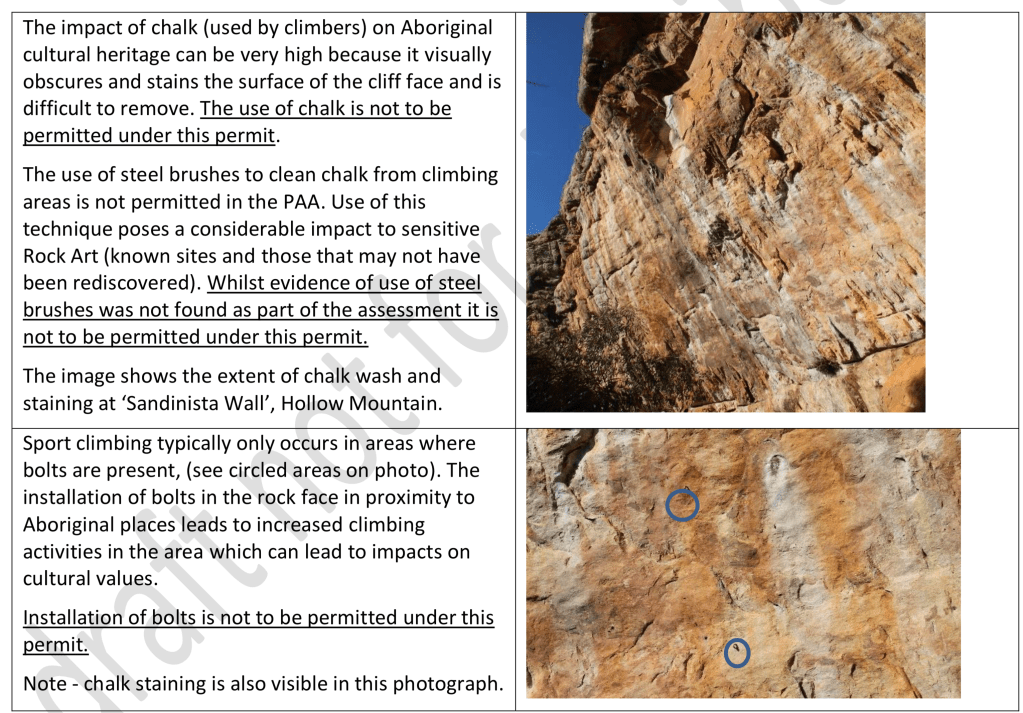
False evidence
The bombshell are the two captions on the photos of Sandinista Wall. We have highlighted them in green.

That’s not chalk!
There is actually no visible chalk in these two images. All the white “staining” is entirely natural and nothing to do with climbers. Let’s break it down…
It’s Geology Stupid
Anyone who climbs in the Grampians knows about the beautiful natural streaks that occur on some of the best crags. Taipan Wall, Van Diemens Land, Wall of Fools and of course Sandinista all feature these rainbow stripes of colour descending the walls.
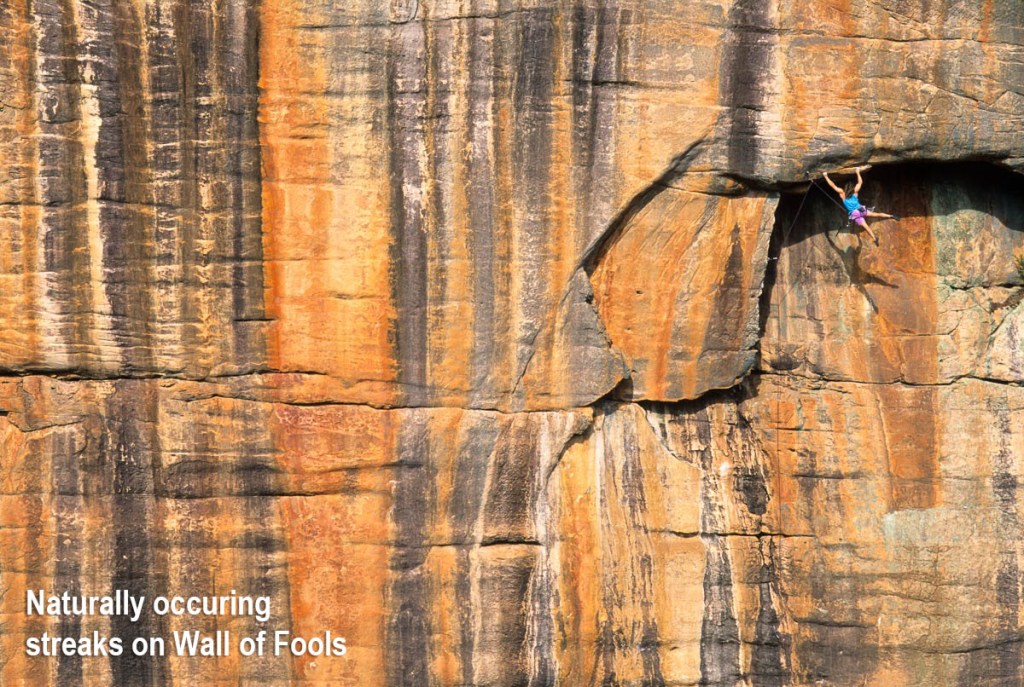
On Sandinista Wall the rock appears to weep streaks of white. What are they? It’s actually the opposite of what you might think. The white streaks (or stains as PV likes to call them) are actually the base rock colour of the majority of Mt Stapylton – it is the quartz. This mineral is pure white (translucent) in colour when uncontaminated with other minerals. Stapylton rock is known as quartz arenite and contains 95% quartz. The orange colours you see on many Grampians cliffs are actually the “stained” sections which form only on overhang areas where moisture evaporation predominates over rain water run off. Iron-pigmentation minerals are carried through the internal section of rock in water and are left on the surface of overhung rock during evaporation and eventually form a crust known as “desert varnish“. On vertical or slabby ground these minerals wash off with rain water leaving just the white rock (which is usually grey in colour because of lichen growth on the surface). But some sections of rock is so porous (hollow) on overhung walls that it can literally “weep” water from weaknesses in the rock. These water streaks remove the iron from the surface and leaves the white stripes – the quartz rock. It’s a bit complex – but the short version is water seeping from the rock naturally causes the streaks – not climbing chalk.

You can also see the same geological process at Van Diemens Land which is located a few hundred metres from Sandinista Wall.
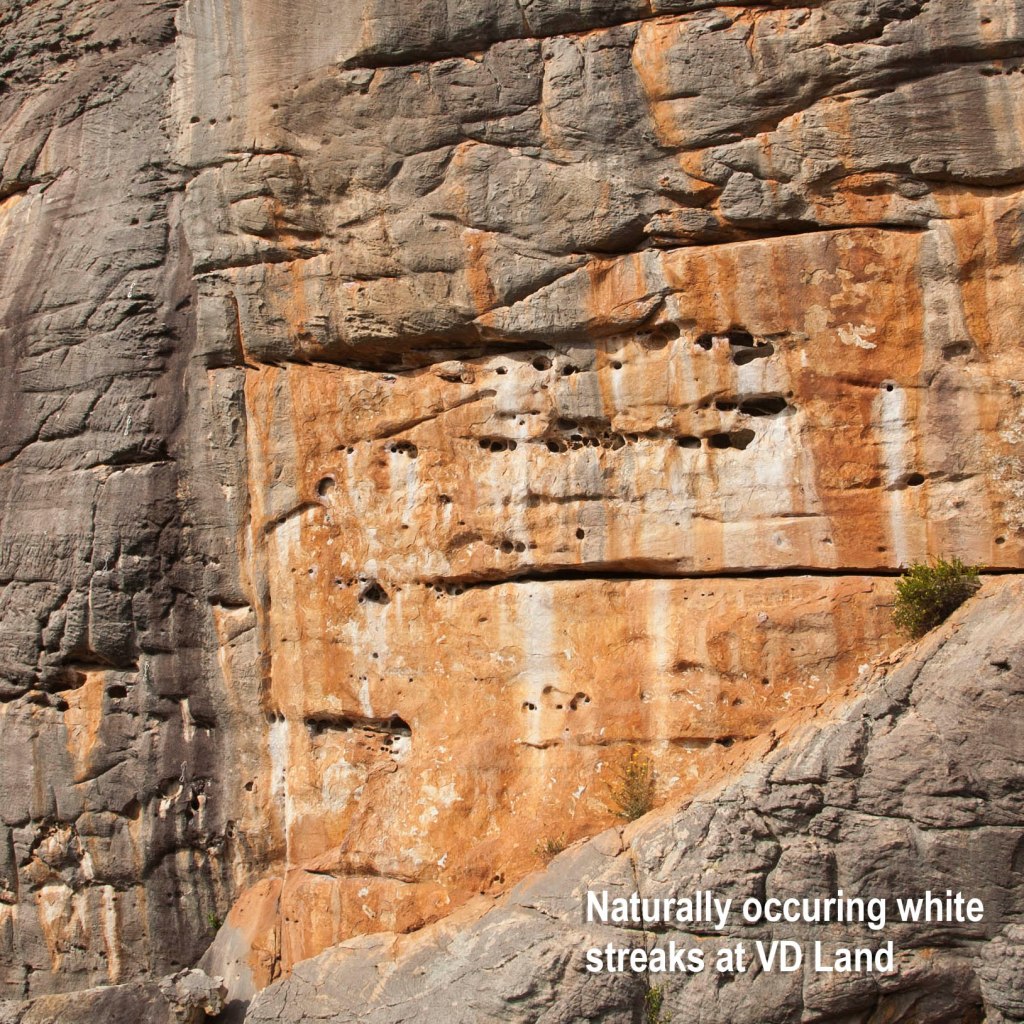
All those incredible white streaks are not chalk – but naturally exposed sections of quartz minerals. The large pockets are the weak points that allow water to escape from inside the rock. Does the PV assessment team think this is climbers chalk as well?
Climbers who have been on Sandinista Wall know it has a reputation for seeping – many of the climbing holds are damp and some even drip with water that is oozing from inside the rock and evaporating on the surface. This is basic Grampians geology 101 – surely the experts PV employed know this? Apparently not.
Poo On You
The other large white streaks seen in the Sandinista images are also seen at many cliff faces throughout the world (even places with no climbers – shock horror). They are streaks of bird poo from raptors. These can accumulate into incredible length down cliffs – sometimes staining 30m or more as clearly seen on Taipan Wall.
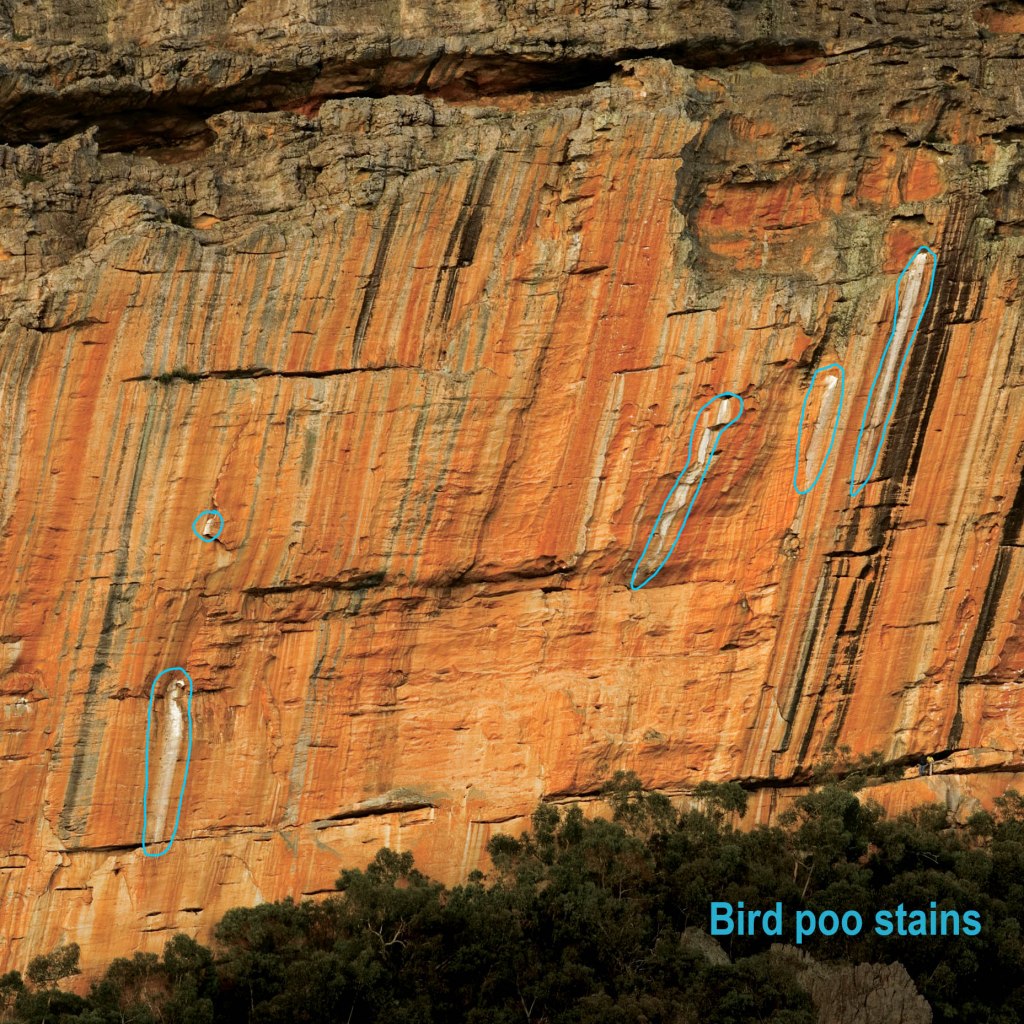
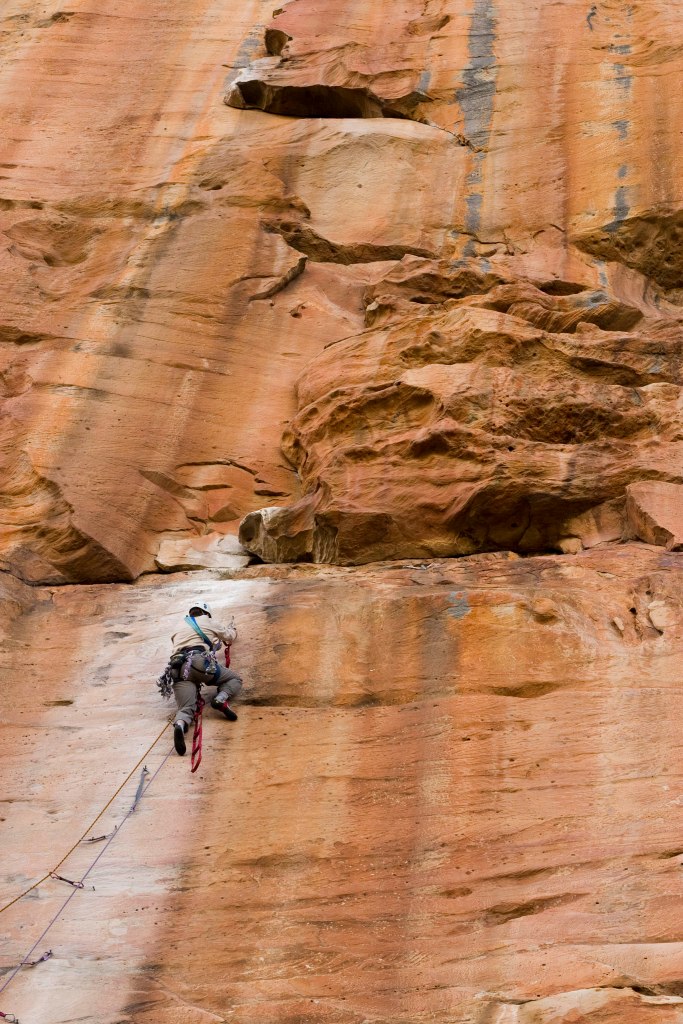
Most of the time these streaks are not located where these birds nest – but instead are convenient spots they perch to survey the landscape below before swooping down to nab some poor unsuspecting animal.

Check the Topo PV!
Three strikes and you’re out? Even more damning is the third reason – climbers actually don’t climb on that section of rock! Let us look at the topo in the current print guidebook – we have put a green border around the section of rock shown in PV’s photo evidence of “chalk”.
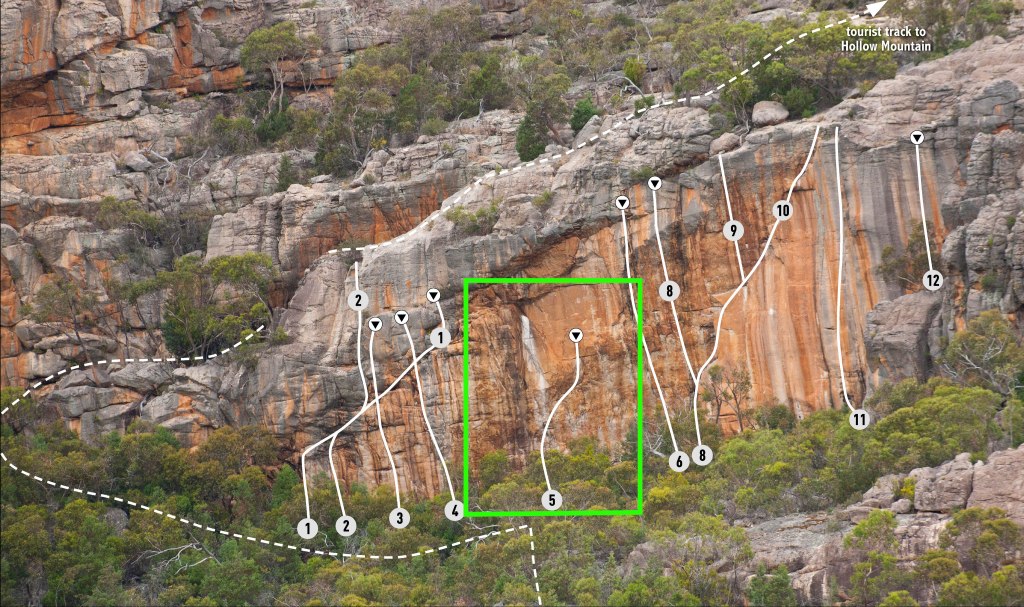
What about route #5? That is actually an abandoned “project” from the late ’90s that was last attempted a decade ago. There is zero chalk on the route – it washed off from rain and seepage a long time ago. As you can see the giant white streak in the middle of the cliff is nothing to do with rockclimbing and everything to do with what Mr Raptor had for dinner last week. All those other white streaks all over the wall? #notclimbers.


Who has been shown this photo?
How can false information like this end up in such an official document? Hasn’t PV employed highly paid experts for these assesments? And if this is just a snippet found in one leaked document – what lurks amoungst the many other secret assessment documents deemed too sensitive to release and out of sight of public scrutiny? This is what happens when you don’t invite any climbers to any of the assessments nor involve them in document creation. Really basic falsehoods have now been presented to government ministers and groups of Traditional Owners months before any climbers got a chance to see them. Just like the incredibly damaging “bolt in art” photo this will have done long term damage to the credibility of climbers in the eyes of land managers. Last time this happened PV assured us it was just a simple mistake and wouldn’t happen again. But here we are. Will PV issue a public apology and retraction to not only climbers – but also to Traditional Owners?
There are very real sections of the Grampians with visible chalk – The Gallery is the obvious one. There is no doubt climbers did that. Why didn’t they use a photo of that area? No wonder they think it’s hard to clean chalk off if it’s actually the natural rock they are looking at much of the time. In one of the presentation slides in the Rountable 4 meeting the figure of $40,000 was shown for a Gallery cleanup and that apparently did not include 150 hours of labour!
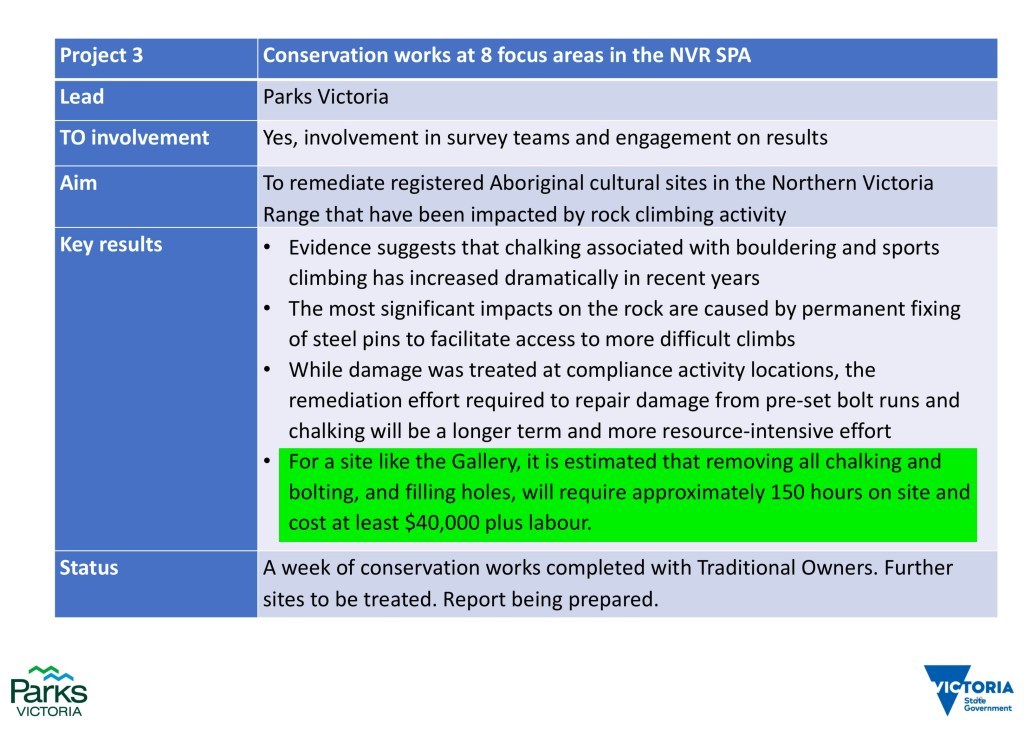
And that is only the start on what these flawed assessments and management solutions are costing the tax payer. A snippet from the notes of RT4 also featured this revelation.
“Parks Victoria has applied for a $400,000 grant from the Commonwealth Government to undertake lidar surveys of the Grampians National Park. This funding only applies to federally listed cultural heritage sites and, if successful, the funds will assist Parks Victoria to identify priority areas for future cultural surveys.”
Half a million dollars to “assist” PV in choosing which are the next areas to survey? Sounds like we should start up a Lidar company quick smart with these sort of lucrative contracts. (Lidar is a way of creating 3D geographic mapping rather than just walking around and looking at cliffs).
Follow the money
So what sort of money are we talking about here? Back in June 2019 Simon Talbot told the ACAV and VCC in a meeting that “$800k to $1.2M has been committed for cultural heritage surveys“. With a public statement like that you can imagine anyone in the assessment industry would be lining up for a slice of that windfall. It is almost impossible to find out who is getting paid what due to commercial in confidence secrecy provisions. But we can get an idea of potential earnings with a bit of snooping.

125 climbing areas have been surveyed so far and apparently at least one representative from each of the three Traditional Owner groups attended each of these assessments. At Summerday Valley it was actually four TO groups – the now dissolved Martang Pty Ltd also attended the assessments. Some groups require that two representatives be present each day for fieldwork. What are they charging? The Victorian Government dept Aboriginal Victoria has issued Fee Guidelines for Registered Aboriginal Parties that shows they can expect anywhere between $50 to $120 an hour for attending these surveys.
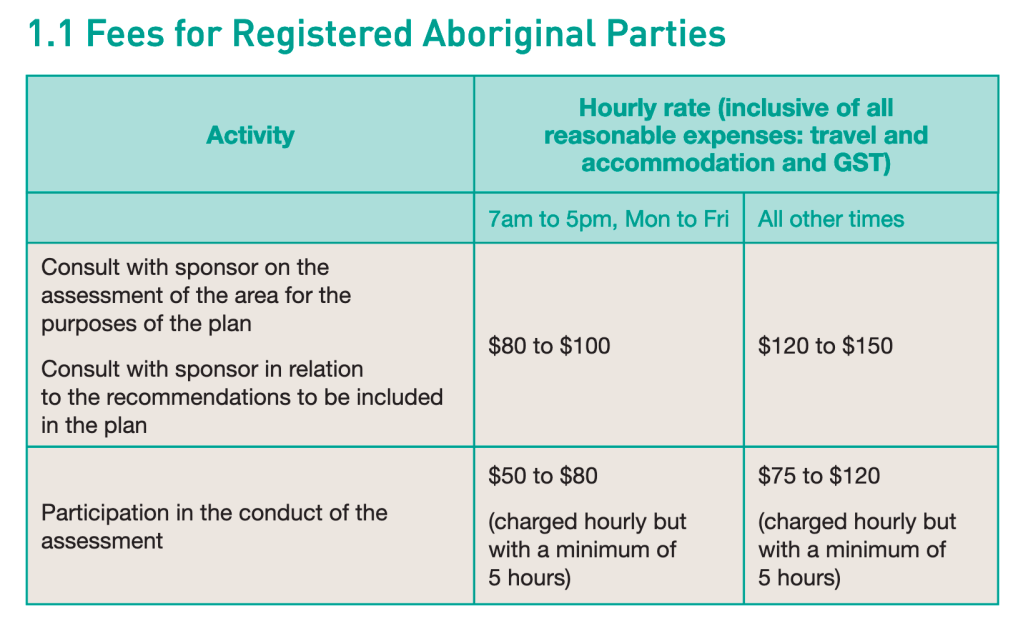
Field assessments are the lower of the two fees with a maximum recommended rate of $80 an hour if work is completed in normal business hours. That is $640 a day for an 8 hour day – and is supposed to include reasonable travel expenses and accommodation. Now these are just government guidelines of course – each group can set their own fees. Lets compare these guidelines with an actual TO corporation who worked on the Grampians assessments, Eastern Maar, using their 2019 rate card.
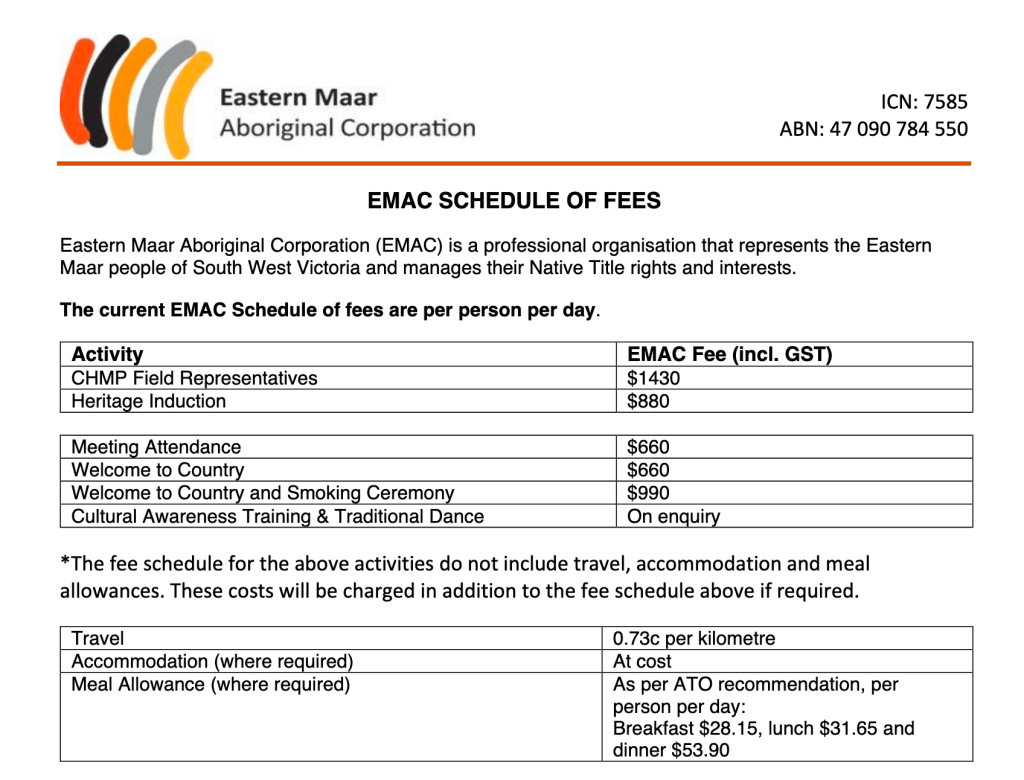
According to this document they charge $1430 a day for a Cultural Heritage Management Plan field representative – more than twice the fee recommend in the Aboriginal Victoria guidelines. And then add their travel allowance – which is not included in their $1430 fee. It is about 200km from EMAC’s home base in Warrnambool to the Hollow Mountain carpark. At 73c per kilometre a 400km round trip adds another $292 to the daily bill. That is per person per day. Now multiply it by the amount of people who are seen in that assessment photo above. It is entirely realistic to think $10,000 per day could be being spent on doing these flawed assessments. PV’s budget of $1 million for cultural heritage surveys will be eaten up quickly at that rate.
And it’s never going to be a competitive tender process for who does this work – these TO corporations are required to be included as one of the potential Registered Aboriginal Parties for the area. Every decision Parks Victoria makes regarding Gariwerd has to be run past these groups presumably using the above rate card.
Why wouldn’t they take full financial advantage of this situation? TO corporations are set up to benefit their own people (family members) and this sort of job is a good steady income stream when you have hundreds of climbing areas across 1600km² of Gariwerd (and that excludes Black Range and Arapiles).
Is it any wonder the commercial climbing companies are being put through a complex and bureaucratic solution to climbing in Summerday when the government is splashing around so much money? But does money always buy expertise? The Sandinista Wall example appears to show this is not the case. Who made the mistake? Was it the same archeologist who mistakes tourist graffiti for climbers? Or the PV staff member who photographed a bolt placed by their own department in rock art and blames it on climbers? Or the bureaucrat who misinterpreted data from thecrag.com and inflated climbing growth ten fold? Or the environmental assessment team that managed to place the decimal point in the wrong place to claim climbers had damaged vegetation 10 times more their own survey showed? With this sort track record we have to ask – how much are they going to put aside for a chalk clean up of Sandinista Wall? Boom. Tish.
Key dates to look out for in the future:
• Late May – PV’s CEO Matthew Jackson said the next (and final) Roundtable Meeting would be held in “late May” – but no specific date has been announced. Don’t hold your breath on this one. Covid might be a convenient excuse for them to cancel this.
• June – The draft version of the Greater Gariwerd (Grampians) Landscape Management Plan is handed over to the Victorian Minister – and then presumably presented to the public for feedback. Get those protest letter writing pencils sharpened. This will be big.
Please share this article and don’ t forget to check out the other 50+ articles on this blog for further background reading.
Update 25th May 2020 – PV doubles down on stupid
Parks Victoria have sent the Licensed Tour Operators a revised permit application – labeled final. You would think at this juncture, and considering the evidence presented above, they would have removed all mention of Sandinista Wall and replaced it with something else. You can’t help stupid it appears.
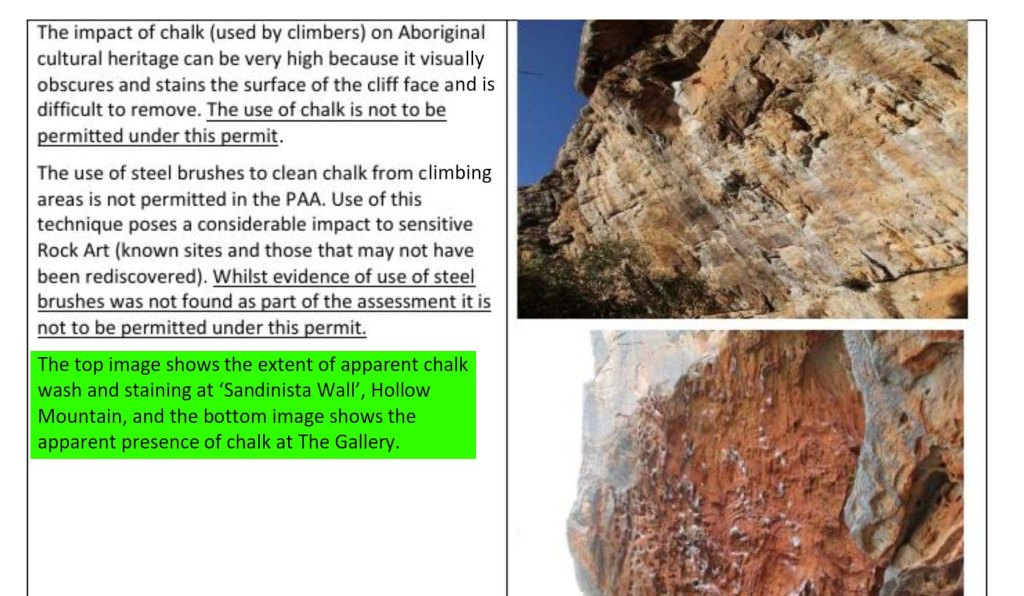
Sandinista now has “apparent chalk wash and staining” according to the revised photo caption. Nice use of “apparent” to dodge a legal bullet. Good to see they took Save Grampians Climbing advice and inserted an image of The Gallery to demonstrate real chalk on a cliff. Our invoice is in the mail PV.

Thanks for the great write up as always sgc, the lack of genuine good will and incompetence that PV have continued to display, combined with with the revelations they have been incentivising inefficient and costly beauracratic process divorced from the boots on the ground reality of the climbing situation has me now again, livid.
After being swooped at West flank this morning by a curious and seemingly unphased wedge tailed eagle, I pray that future generations of all Australians get to enjoy the proximity with nature that climbing brings. The value to me and my friends of that moment was priceless.
The park is alive, here and now; culture and history are great, but in my opinion, only insofar as they bring an individual back into the present experience. Like a good climb or walk does.
This fascination with preserving the old at the cost of finding balance with contemporary meaningful connection to the land is a broader symptom of the insanity of our times.
Keep up the good, tireless and painstaking work, I appreciate you keeping on their case and calling out these malicious and ignorant falsehoods.
LikeLike
This article reeks of paternalistic racism. It’s colonialistic and you should be ashamed. You have no right to determine what is culturally significant or not. Aboriginal peoples are free to set whatever fees they want for settlers to access their rightful lands. Aboriginal peoples are free to do whatever they wish to their property.
LikeLike
Parks Victoria cannot be trusted on any level. This is continually being exposed but nothing happens. They have lied about there proposed Brumbies cull. They have lied about bush fires. The list is ongoing. There needs to be a parliamentary vote of no confidence in the minister and her department. Michael Pardew
LikeLike